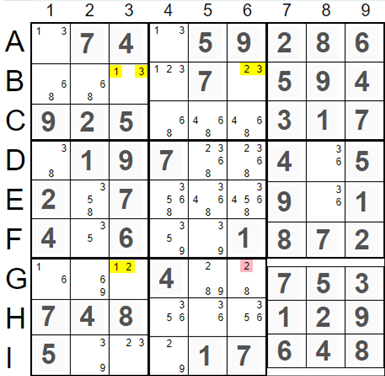
An example of the Y-Wing pattern is shown in the picture on the left. The Y-Wing is formed by four cells: B3, B6, G3, and G6, with possible values of
'1',
'2', and
'3' marked yellow. If cell B3 has a value of 1, then cell G3 must have a value of 2. If cell B3 has a value of 3, then cell B6 must have a value of 2. This means that, in any scenario, the number 2 should be in either cell G3 or G6. However, the number 2 cannot be in cell G6 since it is connected to both cells G3 and B6. Therefore, we can remove the hint of
'2' marked red from cell G6.
Unlike the X-Wing pattern, the four cells in a Y-Wing pattern do not necessarily form a rectangle.